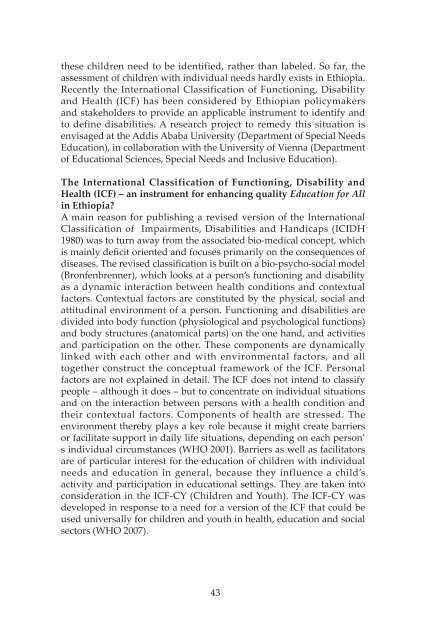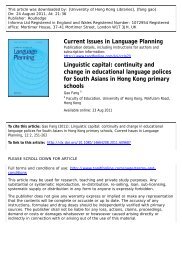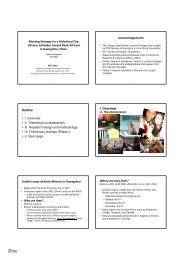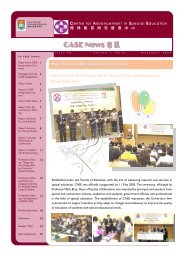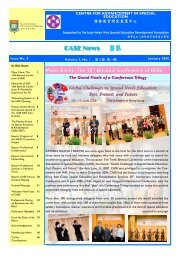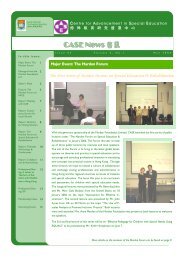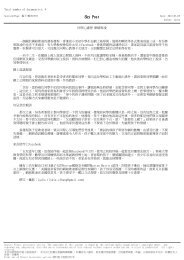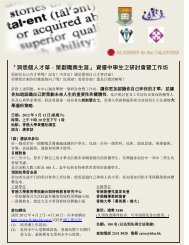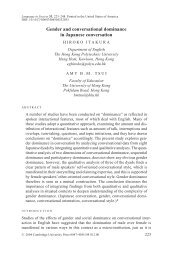Comparative Education Bulletin - Faculty of Education - The ...
Comparative Education Bulletin - Faculty of Education - The ...
Comparative Education Bulletin - Faculty of Education - The ...
You also want an ePaper? Increase the reach of your titles
YUMPU automatically turns print PDFs into web optimized ePapers that Google loves.
these children need to be identified, rather than labeled. So far, the<br />
assessment <strong>of</strong> children with individual needs hardly exists in Ethiopia.<br />
Recently the International Classification <strong>of</strong> Functioning, Disability<br />
and Health (ICF) has been considered by Ethiopian policymakers<br />
and stakeholders to provide an applicable instrument to identify and<br />
to define disabilities. A research project to remedy this situation is<br />
envisaged at the Addis Ababa University (Department <strong>of</strong> Special Needs<br />
<strong>Education</strong>), in collaboration with the University <strong>of</strong> Vienna (Department<br />
<strong>of</strong> <strong>Education</strong>al Sciences, Special Needs and Inclusive <strong>Education</strong>).<br />
<strong>The</strong> International Classification <strong>of</strong> Functioning, Disability and<br />
Health (ICF) – an instrument for enhancing quality <strong>Education</strong> for All<br />
in Ethiopia?<br />
A main reason for publishing a revised version <strong>of</strong> the International<br />
Classification <strong>of</strong> Impairments, Disabilities and Handicaps (ICIDH<br />
1980) was to turn away from the associated bio-medical concept, which<br />
is mainly deficit oriented and focuses primarily on the consequences <strong>of</strong><br />
diseases. <strong>The</strong> revised classification is built on a bio-psycho-social model<br />
(Bronfenbrenner), which looks at a person’s functioning and disability<br />
as a dynamic interaction between health conditions and contextual<br />
factors. Contextual factors are constituted by the physical, social and<br />
attitudinal environment <strong>of</strong> a person. Functioning and disabilities are<br />
divided into body function (physiological and psychological functions)<br />
and body structures (anatomical parts) on the one hand, and activities<br />
and participation on the other. <strong>The</strong>se components are dynamically<br />
linked with each other and with environmental factors, and all<br />
together construct the conceptual framework <strong>of</strong> the ICF. Personal<br />
factors are not explained in detail. <strong>The</strong> ICF does not intend to classify<br />
people – although it does – but to concentrate on individual situations<br />
and on the interaction between persons with a health condition and<br />
their contextual factors. Components <strong>of</strong> health are stressed. <strong>The</strong><br />
environment thereby plays a key role because it might create barriers<br />
or facilitate support in daily life situations, depending on each person’<br />
s individual circumstances (WHO 2001). Barriers as well as facilitators<br />
are <strong>of</strong> particular interest for the education <strong>of</strong> children with individual<br />
needs and education in general, because they influence a child’s<br />
activity and participation in educational settings. <strong>The</strong>y are taken into<br />
consideration in the ICF-CY (Children and Youth). <strong>The</strong> ICF-CY was<br />
developed in response to a need for a version <strong>of</strong> the ICF that could be<br />
used universally for children and youth in health, education and social<br />
sectors (WHO 2007).<br />
43


